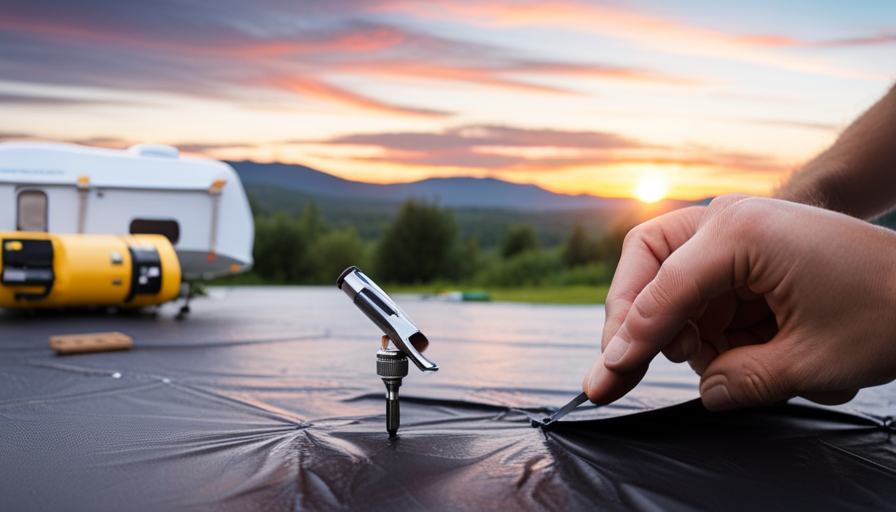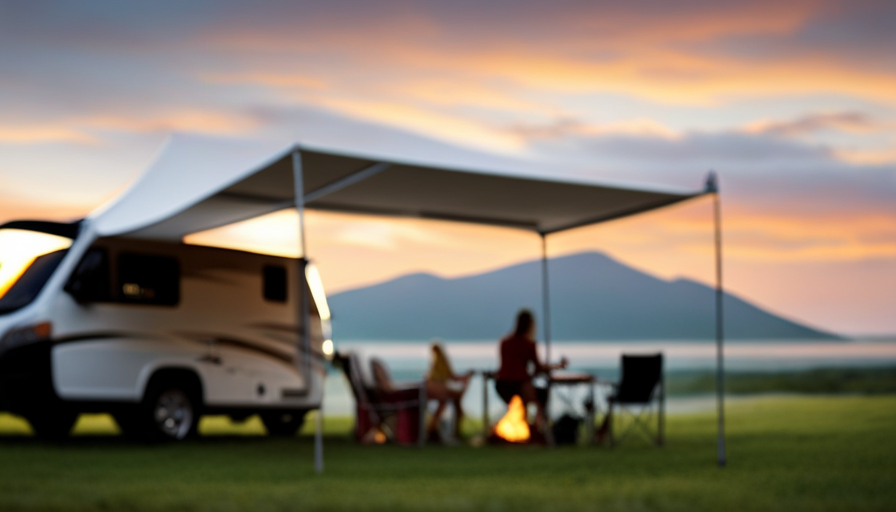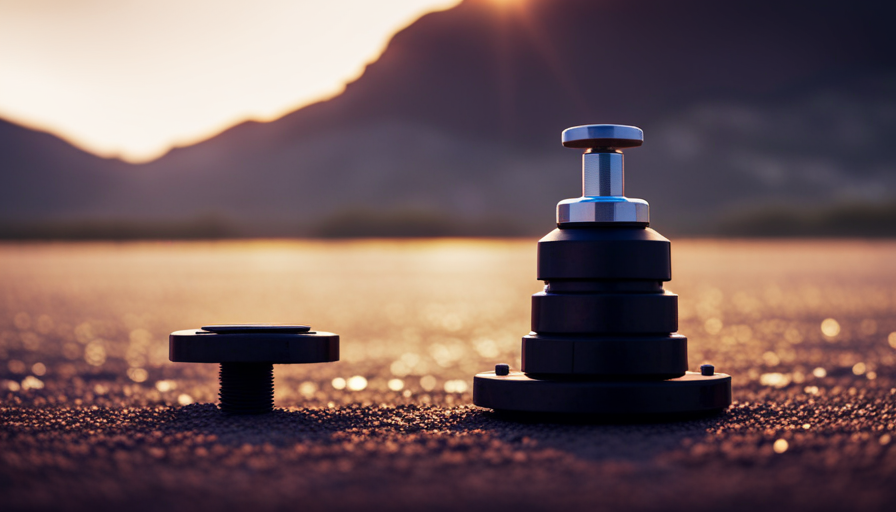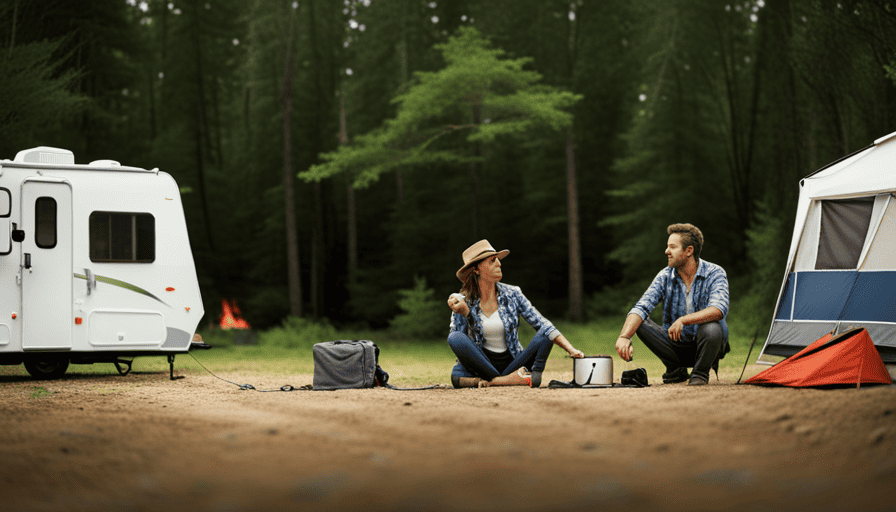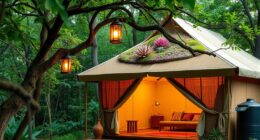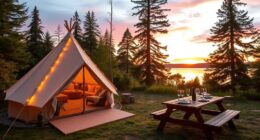Tired of waking up to a damp pop-up camper every time it rains? Well, you’re in luck! You’ve found the solution you’ve been looking for. This helpful guide will show you how to waterproof your pop-up camper canvas, ensuring a dry and cozy camping experience. Say goodbye to pesky leaks and hello to a comfortable oasis in the great outdoors.
Now, you might be thinking, ‘Waterproofing? That sounds like a daunting task!’ But fear not, fellow campers, because we’ve got your back. With our expert tips and step-by-step guide, you’ll be able to tackle this project with ease.
From assessing the condition of your canvas to applying a waterproofing solution and even considering seam sealer, we’ve covered it all.
So, grab your gear and let’s dive into the world of pop-up camper canvas waterproofing. Get ready to conquer the elements and enjoy a camping experience like never before!
Key Takeaways
- Assess the condition of the canvas before waterproofing
- Clean and prepare the canvas before applying a waterproofing solution
- Choose the right waterproofing solution for the canvas material and camping climate
- Regularly maintain and reapply waterproofing to ensure continued protection
Assess the Condition of Your Canvas
Take a close look at the canvas of your pop-up camper, examining it for any signs of wear and tear, such as faded colors or small rips that resemble battle scars from your previous camping adventures. Assessing the canvas durability is crucial before waterproofing it, as any weak spots can lead to potential leaks during heavy rain or unexpected storms.
Look for areas where the fabric may have become thinner or where the stitching may have come undone. These are common places for water to seep through and cause damage to the interior of your camper.
Identifying potential leaks is another important step in assessing the condition of your canvas. Pay close attention to areas where the canvas meets the roof or the sides of the camper, as these are often vulnerable spots. Look for signs of moisture or discoloration, as these can indicate that water is finding its way in. Additionally, check the zippers, seams, and windows for any signs of wear that may compromise the waterproofing of your camper.
Once you have thoroughly assessed the condition of your canvas and identified any areas of concern, it’s time to move on to the next step: cleaning and preparing the canvas for waterproofing.
Clean and Prepare the Canvas
To start, make sure you thoroughly clean and dry the fabric of your camper’s sleeping quarters before applying any protective sealants. Cleaning the canvas is essential to ensure that the waterproofing solution adheres properly and effectively.
There are several canvas cleaning techniques you can use, depending on the level of dirt and stains. For light dirt and debris, you can use a soft brush or sponge with mild soap and water. For tougher stains, consider using a specialized canvas cleaner or a mixture of vinegar and water. After cleaning, make sure to rinse off any soap residue and allow the canvas to dry completely.
Once the canvas is clean and dry, it’s time to choose the right waterproofing solution. There are various options available, including silicone-based sprays, wax-based products, and water repellent solutions. Consider the specific needs of your camper and the climate conditions you’ll be facing. Silicone-based sprays are popular for their durability and ability to repel water effectively. Wax-based products provide a protective layer that can withstand harsh weather conditions. Water repellent solutions are a great choice if you’re looking for a more eco-friendly option.
In the next section, we’ll discuss how to apply a waterproofing solution to your camper’s canvas, ensuring long-lasting protection against the elements.
Apply a Waterproofing Solution
Get ready to give your camper’s sleeping quarters a protective shield against the elements by applying a waterproofing solution that’ll keep you cozy and dry during your outdoor adventures. Waterproofing your pop up camper canvas is essential to ensure its longevity and maintain your comfort while camping.
Here are four alternative waterproofing methods that you can consider:
-
Silicone-based waterproofing spray: This solution creates a protective barrier on the canvas, preventing water from seeping through and causing damage.
-
Wax-based waterproofing: Applying a wax-based solution to the canvas helps repel water and keeps it from saturating the fabric.
-
Polyurethane coating: This method involves applying a thin layer of polyurethane to the canvas, providing excellent waterproofing and UV protection.
-
Seam sealer: Paying attention to the seams and stitching is crucial, as these areas are often the weakest points. Using a seam sealer can help reinforce these areas and prevent water from leaking through.
Waterproofing your pop up camper canvas offers several benefits. It protects your sleeping quarters from rain, snow, and other weather conditions, ensuring a dry and comfortable camping experience. Additionally, it helps prevent mold and mildew growth, prolonging the life of your canvas.
So, let’s dive into the next section and learn more about how to pay attention to seams and stitching when waterproofing your pop up camper canvas.
Pay Attention to Seams and Stitching
Inspect the seams and stitching closely, as they’re crucial areas that require attention when ensuring the longevity and protection of your sleeping quarters against the elements.
When it comes to waterproofing techniques and common canvas maintenance, paying attention to the seams and stitching is essential. These areas are prone to wear and tear, which can compromise the effectiveness of your waterproofing efforts.
Start by carefully examining each seam and stitching to identify any signs of damage or weakness. Look for frayed threads, loose stitches, or gaps between the fabric panels. If you notice any issues, it’s important to address them promptly to prevent water from seeping through.
To reinforce the seams and stitching, consider using seam sealer. Seam sealer is a waterproofing product specifically designed to seal and protect the seams of your pop-up camper canvas. Apply the seam sealer along the seams and stitching, ensuring that all areas are thoroughly covered. This will create a waterproof barrier that prevents water from penetrating through the seams. Additionally, it’ll help to strengthen the seams, prolonging the lifespan of your canvas.
By inspecting the seams and stitching and using seam sealer, you can effectively waterproof your pop-up camper canvas and enhance its durability.
Transitioning into the next section, considering the use of seam sealer is an important step in maintaining the integrity of your camper’s canvas.
Consider Using Seam Sealer
Enhance the longevity and protection of your sleeping quarters by considering the use of seam sealer, a valuable tool for reinforcing and sealing crucial areas of your camper.
When it comes to waterproofing your pop-up camper canvas, there are various alternative methods available, but seam sealer stands out for its numerous benefits.
Seam sealer is specifically designed to prevent water from seeping into the seams and stitching of your camper canvas. It works by creating a waterproof barrier that keeps moisture out, ensuring that your sleeping quarters stay dry even in the harshest weather conditions. This is especially important because seams and stitching are often vulnerable points where water can easily penetrate.
One of the main benefits of using seam sealer is its ease of application. It typically comes in a tube or bottle with an applicator, making it simple to apply directly onto the seams and stitching. Additionally, seam sealer is durable and long-lasting, providing a reliable waterproof seal that can withstand repeated use and exposure to the elements.
Consider using seam sealer as part of your waterproofing routine to ensure maximum protection for your pop-up camper canvas. Once you’ve reinforced and sealed the crucial areas, you can move onto the next step: applying a UV protectant to further safeguard your camper against sun damage.
Apply a UV Protectant
To ensure the longevity of your sleeping quarters, make sure you apply a UV protectant to shield your camper from sun damage. The sun’s rays can be incredibly harsh and can cause the canvas of your pop-up camper to fade, crack, and deteriorate over time. By using a UV protectant, you can extend the life of your camper’s canvas and keep it looking great for years to come.
There are several benefits to using a UV protectant on your pop-up camper canvas. Firstly, it helps to prevent fading caused by UV rays. This is especially important if you have a brightly colored or patterned canvas that you want to keep looking vibrant. Additionally, a UV protectant helps to prevent the canvas from becoming brittle and cracking. This is crucial for maintaining the integrity of your camper and ensuring it remains waterproof.
When choosing a waterproofing solution with UV protection, there are a few tips to keep in mind. Look for a product specifically designed for use on outdoor fabrics and canvas. It should provide long-lasting protection and be easy to apply. Consider products that offer additional benefits such as mildew resistance and water repellency.
By applying a UV protectant to your pop-up camper canvas, you can enjoy the benefits of added sun protection and ensure your camper stays in top shape.
Next, we’ll discuss how to test the waterproofing of your camper’s canvas.
Test the Waterproofing
Make sure you’re fully prepared for any rainy camping adventure by putting your camper’s waterproofing to the ultimate test. After applying a UV protectant to your pop-up camper canvas, the next step is to test the waterproofing. This step is crucial to ensure that your camper will withstand even the heaviest rainstorms.
To test the waterproofing, you can use a hose or a sprinkler system. Set up your camper and extend the canvas fully. Then, spray water onto the canvas from different angles and areas. Pay close attention to seams, corners, and zippers, as these are the most vulnerable spots. Observe if the water beads up and rolls off the canvas or if it seeps through.
Once you have completed the test, compare the performance of different waterproofing products. Some may provide better water repellency and protection than others. Consider factors such as durability, ease of application, and the ability to withstand UV rays.
When choosing a waterproofing solution, keep in mind that it should be compatible with your camper’s canvas material. Additionally, consider any specific instructions or recommendations from the manufacturer.
Regularly maintaining and reapplying waterproofing is essential to keep your pop-up camper protected from rain and moisture. By following these tips for choosing a waterproofing solution and regularly maintaining it, you can ensure that your camper will stay dry and comfortable during your camping adventures.
Regularly Maintain and Reapply Waterproofing
Don’t forget to regularly maintain and reapply the waterproofing on your camper’s canvas to ensure it stays protected from rain and moisture during your camping adventures. Maintaining waterproofing is crucial to prolonging the life of your camper’s canvas and preventing water damage.
Here are three important steps to help you effectively maintain and reapply waterproofing:
-
Clean the canvas: Before reapplying waterproofing, make sure to clean the canvas thoroughly. Remove any dirt, debris, or mildew using a soft brush and mild soap. Rinse it off and let it dry completely before moving on to the next step.
-
Choose the right waterproofing product: There are various waterproofing products available in the market, such as sprays, solutions, and waxes. Consider the material of your camper’s canvas and the climate you’ll be camping in when selecting the product. Read the instructions carefully and apply the waterproofing product evenly, ensuring complete coverage.
-
Regularly reapply waterproofing: Over time, the waterproofing on your camper’s canvas may wear off due to exposure to elements. It’s recommended to reapply waterproofing at least once a year or whenever you notice water isn’t beading up on the surface.
By regularly maintaining and reapplying waterproofing, you can ensure your camper’s canvas remains protected. Consider investing in a camper cover to provide an extra layer of protection.
Consider Investing in a Camper Cover
Investing in a camper cover is like giving your camper a cozy blanket to protect it from the elements and ensure its longevity.
Camper covers provide a range of benefits that make them worth considering. First and foremost, they shield your camper from rain, snow, and UV rays, preventing any water damage or discoloration. This is especially important for pop-up campers with canvas tops, as they’re more susceptible to water leakage.
A camper cover also acts as a barrier against dirt, dust, bird droppings, and tree sap, keeping your camper clean and reducing the need for frequent cleaning. Furthermore, it provides an extra layer of insulation, helping to regulate the temperature inside the camper and making it more comfortable during extreme weather conditions.
While there are alternatives to camper covers, such as tarps or custom-made canvas covers, they often lack the perfect fit and durability that a specifically designed camper cover offers. Additionally, tarps can flap in the wind, potentially causing damage to the camper. Investing in a high-quality camper cover ensures a snug fit, maximum protection, and ease of use.
By protecting your camper with a cover, you can enjoy a dry and comfortable camping experience without worrying about water damage or a dirty exterior.
Enjoy a Dry and Comfortable Camping Experience
By covering your camper with a durable and snug-fitting protective shield, you can ensure a camping experience that’s both dry and comfortable.
When it comes to waterproofing your pop-up camper canvas, there are several techniques you can employ to keep moisture out and enjoy your outdoor adventures without any worries. The benefits of waterproofing are numerous, as it not only keeps you dry but also prevents mold and mildew from forming inside the camper.
One effective technique is to apply a waterproofing spray or solution to the canvas. This creates a barrier that repels water, ensuring that it beads up and rolls off instead of seeping through. Make sure to choose a product specifically designed for canvas materials, as this’ll provide optimal protection.
Additionally, you can invest in seam sealers to reinforce the stitching on your camper’s canvas. These sealers prevent water from penetrating the seams, which’re often vulnerable areas for leaks. Applying them regularly can significantly enhance the waterproofing capabilities of your camper.
Another important aspect of waterproofing is maintaining the integrity of zippers and windows. Be sure to lubricate the zippers with a silicone-based lubricant to keep them running smoothly and prevent water from seeping in. Similarly, inspect the windows for any cracks or gaps and apply a sealant if necessary.
By employing these waterproofing techniques, you can enjoy a camping experience that’s not only dry but also comfortable. No longer will you need to worry about rainstorms or damp conditions ruining your trip. Stay dry, stay comfortable, and make the most of your outdoor adventures.
Frequently Asked Questions
How long does it take for the waterproofing solution to dry on the canvas?
On average, it takes approximately 24-48 hours for the waterproofing solution to fully dry on the canvas. However, factors such as temperature and humidity can affect drying time. It is important to follow the specific instructions on the waterproofing product you’re using for best results.
When cleaning the canvas, it’s recommended to use specific cleaning products designed for canvas materials rather than regular soap. These products are formulated to effectively remove dirt and stains without damaging the fabric.
Can I use any type of soap to clean the canvas, or are there specific cleaning products I should use?
Using specific cleaning products designed for canvas is highly recommended when cleaning the canvas of a pop-up camper. These cleaning products are specifically formulated to effectively remove dirt, stains, and mildew without damaging the canvas material. They offer several benefits, such as gentle yet thorough cleaning, preserving the fabric’s integrity, and preventing any potential damage.
By using these specialized cleaning techniques and products, you can ensure a thorough and safe cleaning process for your pop-up camper canvas.
Is it necessary to apply a UV protectant if I am already using a camper cover?
Is it really necessary to apply a UV protectant if we’re already using a camper cover? Let’s consider some alternatives to UV protectant for camper canvas.
While camper covers can provide some level of UV protection, they may not be as effective as a dedicated UV protectant. UV protectants are specifically designed to shield the canvas from harmful UV rays, preventing fading, cracking, and deterioration.
So, even with a cover, using a UV protectant is still highly recommended to ensure maximum protection for your pop-up camper canvas.
How often should I reapply the waterproofing solution?
We recommend reapplying the waterproofing solution to your pop-up camper canvas at least once a year. This will help maintain its effectiveness and keep your camper dry during rainy weather.
When it comes to cleaning products, we suggest using mild soap and water to clean the canvas before applying the waterproofing solution. This will ensure that there’s no dirt or debris interfering with the effectiveness of the solution.
Can I use the same waterproofing solution for both the canvas and the seams/stitching?
Yes, you can use the same waterproofing solution for both the canvas and the seams/stitching of your pop-up camper. It’s important to ensure that both the canvas and seams are properly waterproofed to protect against water damage. However, there are alternative waterproofing methods available, such as using seam sealer specifically designed for stitching. Another option is to consider professional canvas waterproofing services, which offer the benefits of expertise and specialized equipment for a thorough and long-lasting waterproofing solution.
Can Waterproofing the Canvas of a Pop Up Camper Help Fix It?
Yes, waterproofing the canvas on a camper popup can help with fixing canvas on camper popup. By applying a waterproofing spray or sealant, you can protect the canvas from moisture and prevent leaks and damage. This can extend the lifespan of the canvas and improve the overall condition of the pop-up camper.
Conclusion
Well, folks, we’ve reached the end of our journey to waterproofing your pop-up camper canvas. Now that you’ve armed yourself with the knowledge and expertise to tackle this task, you’re ready to conquer any camping adventure that comes your way.
Remember to assess, clean, and apply the waterproofing solution with precision and care. Don’t forget about those pesky seams and stitching, and consider using seam sealer for added protection.
And of course, always test your waterproofing skills before hitting the road. With regular maintenance and reapplication, along with the option of a camper cover, you’ll be enjoying dry and comfortable camping experiences for years to come.
Happy camping, my fellow outdoor enthusiasts!

